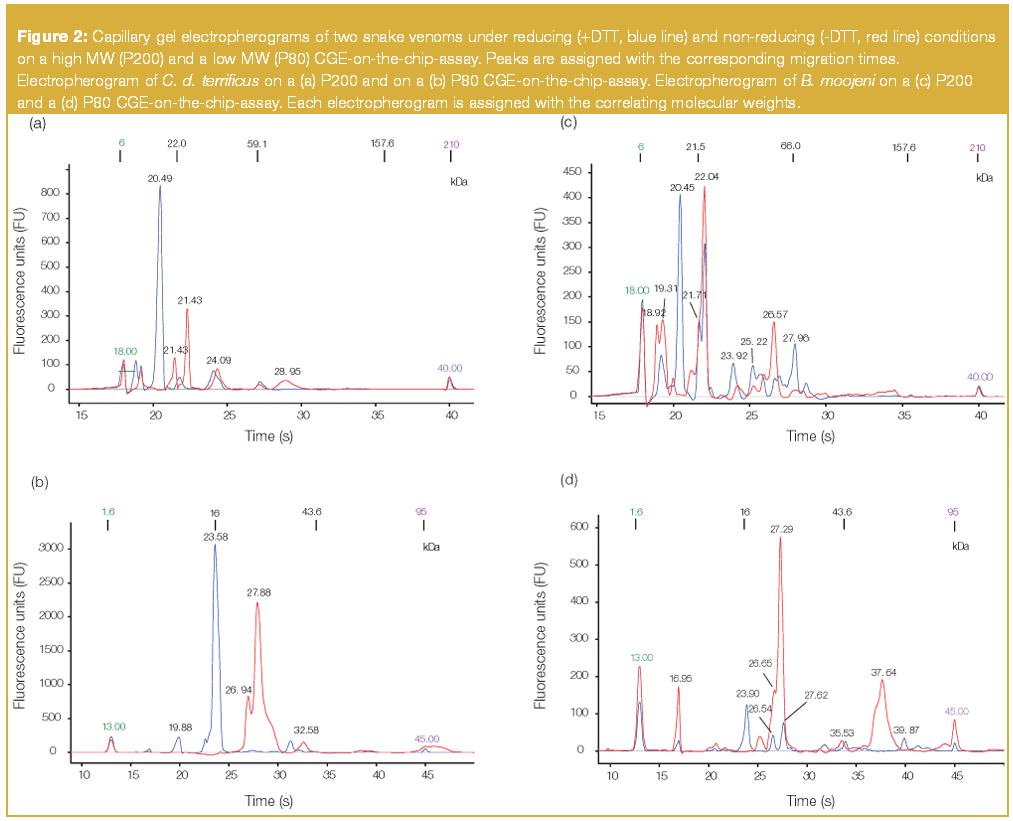On-line SEC–Py-GC–MS for the Automated Comprehensive Characterization of Copolymers
LCGC Europe
Size-exclusion chromatography (SEC) and pyrolysis-gas chromatography (Py-GC) are commonly used to characterize copolymers. SEC is a powerful method to determine the molecular-weight distribution of polymers whereas Py-GC provides valuable information on their chemical composition. The combination of these two techniques could yield combined size and composition information for copolymers or polymer mixtures. A fully automated system was constructed to perform these two-dimensional (2D) characterizations. Several examples of the use of this new technique to comprehensively characterize polymers are described.
Erwin R. Kaal,1,2 Mitsuhiro Kurano,2 Margit Geiβler,3 Peter Schoenmakers1 and Hans-Gerd Janssen,1,4
1Polymer Analysis Group, van ’t Hoff Institute for Molecular Sciences, University of Amsterdam, The Netherlands,
2ATAS GL International, Veldhoven, The Netherlands,
3Shimadzu Europe, Duisburg, Germany,
4Unilever Research and Development, Advanced Measurement and Imaging, Vlaardingen, The Netherlands.
Unlike low-molecular-weight chemicals, polymers are not single compounds. In a polymeric sample many different molecules are present that derive from the same building blocks, but differ in chain length, degree of branching, end-groups, etc. For a thorough understanding of the properties of a copolymer, detailed knowledge of all these features is crucial. It is generally not sufficient to just know the average distribution of single parameters, for example, the molecular weight or the composition. Detailed knowledge on the various distributions is necessary for a true understanding of the polymer, its properties and the mechanisms of its synthesis. To study composition drift in copolymerization reactions, for example, a technique that allows monitoring of the chemical composition as a function of the molecular weight is needed. Clearly, only multi-dimensional analytical techniques can provide this multi-dimensional information. To effectively analyse composition drift, a combination of a size-based separation technique, such as size exclusion chromatography (SEC) and a method for obtaining information on the chemical composition is needed.
Numerous authors have addressed this question. The most logical route is to couple SEC with a spectroscopic detector. Indeed, SEC has been coupled to a wide range of spectroscopic and spectrometric detectors, including ultraviolet (UV), infrared (IR) or nuclear-magnetic-resonance (NMR) spectroscopy, and mass spectrometry (MS).1–4 Unfortunately, each of these methods suffers from its own disadvantages. UV detection, for example, is not truly specific and it is difficult to obtain rigorous quantitative information from IR detection.5 Pyrolysis-GC (Py-GC) presents an attractive alternative for spectroscopic detection after SEC. So far, however, Py-GC has rarely been used as a compositional detector after SEC.
We believe that this is mainly because of difficulties encountered in automating the combination of these techniques and the time-consuming nature of the experiments. The main difficulty in automating SEC–Py-GC–MS experiments lies in the solvent-elimination step required. Previously, this had to be performed manually. Moreover, it is thought to be difficult to obtain truly quantitative information from Py-GC. With the advent of high-temperature programmed-temperature vapourization (PTV) injectors it is now possible to perform both automated solvent elimination of large SEC fractions and pyrolysis of the retained polymer in one device.6–9 A large-volume fraction of the SEC effluent is introduced into the PTV injector. After the solvent has been eliminated, the retained polymer is pyrolysed by rapidly heating the PTV injector to a high final temperature.
The goal of the present report is to describe our fully automated system for SEC–Py-GC and to demonstrate the potential of this new set-up in copolymer analysis. In our instrument the entire SEC effluent is on-line divided into multiple fractions for subsequent Py-GC–MS characterization. Fast GC–MS is used to reduce the total time required for the full characterization of the polymeric sample. The quantitative performance of the PTV injector as a pyrolyser is evaluated. The conditions for solvent elimination and pyrolysis are optimized and fast-GC–MS settings for the identification and quantification of the pyrolysis fragments are determined. The system is applied for the combined size/composition characterization of various polymers, including random copolymers of styrene and methylmethacrylate (MMA) and tri-block copolymers consisting of caprolacton (CL), MMA and butylacrylate (BA).
Experimental
Samples and materials: Low dispersity polystyrene (PS) and polymethylmethacrylate (PMMA) standards and poly(styrene-co-methyl methacrylate) [PS-PMMA] diblock copolymers with different styrene contents and molecular weights were obtained from PSS (Mainz, Germany). Four different PS-PMMA random copolymers were provided by DSM Neoresins (Waalwijk, The Netherlands). Several terpolymers consisting of the monomers MMA, BA and CL were prepared at the Technical University of Eindhoven, The Netherlands. The preparation of these terpolymers has been described in detail by van Hulst et al.10 All polymers were dissolved in tetrahydrofuran [THF] (Biosolve, Valkenswaard, The Netherlands) before analysis.
SEC analysis: For the size separation two Mixed-C SEC columns of 7.8 × 300 mm i.d. were used (Polymer Labs, Church Stretton, Shropshire, UK). The mobile phase was THF at a flow-rate of 0.5 mL/min. A Shimadzu Prominence LC-20AD pump (Shimadzu, Den Bosch, The Netherlands) and a Shimadzu SPD-M20A PDA detector were used in the SEC system. At the exit of the SEC column the effluent was split. Approximately 70% was sent to the UV detector. The remainder was directed to the PTV SEC–Py-GC interface. For the introduction of the sample into the SEC, as well as for transfer of the SEC fractions to the Py-GC, a Focus XYZ robotic autosampler with a 12 µL sample loop (ATAS GL, Veldhoven, The Netherlands) was used.
GC analysis: All Py-GC–MS experiments were performed on a Shimadzu GCMS-QP2010 equipped with an Optic 3 PTV injector (ATAS GL) containing a fritted liner. GC analyses were performed on an InertCap 30 m × 0.25 mm i.d. TC 5MS (5% phenyl-methylpolysiloxane) column with a film thickness of 0.25 µm (GL Sciences, Tokyo, Japan) using helium as the carrier gas at a flow-rate of 1 mL/min. For the Py-GC–MS characterization of the polymer mixtures and di-block and random copolymers of PS and PMMA an isothermal oven temperature of 130 °C was used. For the analysis of the PBA-PMMA-PCL terpolymer the GC-oven was programmed from 70 °C (2 min initial hold) to a final temperature of 150 °C (2 min) at a programming rate of 100 °C/min.
SEC–Py-GC transfer: For the automated transfer of fractions from the SEC to the Py-GC a 100 µL 'side port' syringe (ATAS GL) was installed in the Focus auto sampler. This syringe contains a fluid entrance at the top of the barrel, allowing the SEC effluent to be collected in the syringe. The storage volume created in this way is approximately 100 µL. In the on-line set-up, the SEC dimension is operated in the stop-flow mode. During the "flow-on" time the SEC effluent is collected in the syringe. Next, the SEC flow is stopped and the sample stored in the syringe is injected into the PTV injector at a controlled rate. In the PTV the solvent is evaporated, where after the retained polymer is pyrolysed. Typical fraction-collection ("flow-on") times are 15 or 20 seconds. Using the SEC flow and split ratio selected the fraction volume was approximately 35 µL. Conventional 1 µL injections of standard polymer solutions were performed at a speed of 100 µL/s. More details on the experimental set-up are given elsewhere.9
Solvent elimination and pyrolysis: Solvent elimination in the PTV injector was performed at 150 °C. The additional solvent vent time applied after completion of the transfer of a fraction was 30 seconds. For pyrolysis the injector was programmed from 150–550 °C at 30 °C/s. The split-flow-rate was 150 mL/min during solvent elimination and 10 mL/min during pyrolysis and sample transfer (1.5 min), with a subsequent increase to 50 mL/min for the remainder of the run. The GC programme was started when the PTV injector had reached the final pyrolysis temperature.
Results and Discussion
A schematic representation of the newly developed instrument for automated SEC–Py-GC–MS is shown in Figure 1. The principle of operation of the system is adopted from the work of de Koning et al.8 who developed it for comprehensive LC×GC. The principle of operation can be summarized as follows. Fractions from the SEC effluent are collected in the syringe. Next, the SEC flow is stopped and the fraction stored in the syringe is introduced into the PTV injector, where the solvent is eliminated. The dried polymer is than pyrolysed by rapidly ramping up the injector temperature. The pyrolysis fragments are first refocused on the top of the GC column, then separated and finally detected by the MS. At the end of the GC run the SEC flow is resumed again and the entire process is repeated. The advantage of using a high-temperature PTV injector as the pyrolysis interface is that it can accommodate large volumes of solvent, in contrast to conventional pyrolysers that generally tolerate only sub-microlitre sample quantities. The ability to accommodate and evaporate large volumes of solvent in the actual pyrolyser greatly assists on-line SEC–Py-GC. By incorporating a flow splitter between the SEC column and the syringe, standard 7.8 mm i.d. SEC columns can be used, which eliminates the need to work with miniaturized SEC columns.
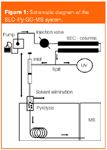
Figure 1
Before starting SEC–Py-GC experiments, the conditions for solvent elimination and pyrolysis have to be optimized. Optimization of the conditions for solvent elimination is not critical because of the great difference in volatility between polymers and solvents. The injector temperature and the split flow have to be selected to give conditions where the rate of evaporation of the solvent approximately equals the rate of liquid introduction. To achieve rapid evaporation, an evaporation temperature of approximately 40 °C above the boiling point of the THF was used. During solvent elimination the split flow was 150 mL/min.
Under these conditions the maximum rate of introduction for THF was found to be approximately 60 µL/min. At higher sample introduction rates liquid sample left the liner flushing with it polymer solution. This resulted in a decreased sensitivity and a poor repeatability. If properly optimized, the relative standard deviations (RSDs) for the absolute peak areas of the pyrolysis fragments MMA and styrene obtained from 25 µL injections of standard solutions of PMMA and PS in THF were 2.9% and 3.6% (n = 20), respectively.
The main aim of our work was the quantitative size/composition characterization of mixtures of homopolymers and of copolymers. Clearly, in our case Py-GC–MS is not only used to identify the monomers present, but also for quantification of their levels. For the data to be reliable, the Py-GC–MS part of the system should therefore provide accurate compositional information. This implies that a quantitative relationship should exist between the composition of the polymer and the monomer ratios obtained in the Py-GC–MS analysis. Moreover, this relationship should hold irrespective of the mass of polymer present in a SEC fraction, the polymer's molecular weight, or its composition, because in the SEC effluent all these parameters can change continuously. To study the impact of the various factors, a series of model experiments was performed. The influence of the molecular weight (MW) and the sample mass was evaluated by pyrolysing different amounts of homopolymers and copolymers of different molecular weight. These experiments clearly showed that there was no effect of Mr and the sample mass on the pyrolysis process.9
In the current method for on-line SEC–Py-GC–MS, the SEC chromatogram is divided into 40–60 fractions (Py-GC–MS runs). To keep the total analysis time at an acceptable level the GC–MS run should be as fast as possible. Fortunately, because an MS is used as the detector, the requirements on the chromatographic resolution are somewhat lower and a relatively short GC column can be used. Ideally, the column is operated isothermally, to eliminate the need for cooling and re-equilibration at the end of each GC run. A difficulty encountered in isothermal operation is that traces of the SEC effluent (THF), which remain in the liner even after extensive solvent elimination, will coelute with the most volatile pyrolysis fragments. By using a high initial PTV temperature, a high gas flow during solvent elimination and a liner with a wide-pore frit, the mass of residual solvent can be kept to a minimum. If specific masses of the monomer fragments are used for quantification, this small amount of solvent usually can be tolerated.
A second complication when operating the GC isothermally is that the pyrolysis fragments are not refocused on the analytical column, which can give rise to rather broad peaks. In our experiments isothermal conditions could be used for the PS-PMMA copolymers. Here GC run times of 2 min could be obtained, allowing a full characterization of a polymer sample within 2 hours. For the terpolymers isothermal analysis was not feasible. Still, by using a GC capable of rapid heating and cooling, the GC–MS run time for each SEC fraction could be kept below 5 min. The total analysis time for a SEC–Py-GC–MS run was then around 4 hours.
For quantitative use of Py–GC–MS data, the monomer ratio of the polymeric sample should be accurately reflected in the relative intensities of the fragments formed during pyrolysis. To study this aspect, several blends of di-block and random PMMA–PS copolymers of known composition were prepared and analysed. The experimental Py-GC–MS monomer ratios were calculated using concentration calibration curves recorded for the separate homopolymers analysed under the same conditions and the results were compared with the values specified by the manufacturer.
Table 1 shows a comparison of experimental MMA/styrene ratios and manufacturer data. The results show an excellent agreement between the experimental Py-GC ratios and the values specified by the manufacturer, especially when bearing in mind that the latter also harbour a degree of uncertainty. For the polymers studied, the peak intensities of pyrolysis products, originating from equal masses of a monomer present in any kind of homopolymer or copolymer studied, clearly are identical. This demonstrates that the Py-GC–MS system can be used as a monomer-selective quantitative detector after SEC.
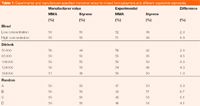
Table 1: Experimental and manufacturer-specified monomer ratios for mixed homopolymers and different copolymer standards.
To demonstrate the reliability and accuracy of the on-line SEC–Py-GC–MS system, it was applied to the characterization of a mixture of random PMMA–PS copolymers of known composition. An interesting feature of this copolymer is that styrene shows strong UV absorption, whereas the MMA is UV transparent. This means that the SEC concentration profile of the copolymer mixtures obtained with UV detection can be directly compared to the styrene concentration graph obtained from our SEC–Py-GC–MS approach. Figure 2 shows an overlay of the SEC-UV and SEC–Py-GC–MS traces of styrene. The SEC–Py-GC–MS trace was constructed by plotting the intensities of the styrene fragments formed during pyrolysis versus the SEC elution volume. These results clearly indicate that the quantitative information from Py-GC–MS is identical to that of UV detection. It can also be seen from Figure 2 that significant band broadening as a result of the stop-flow operation is absent. The peak shape and the resolution in automated on-line SEC–Py-GC–MS and SEC–UV are identical.
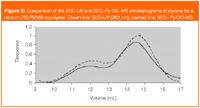
Figure 2
Figure 3 shows the combined concentration graphs of MMA and styrene obtained with SEC–Py-GC–MS for a random PMMA–PS copolymer. This figure demonstrates the great advantage of Py-GC–MS as a monomer-selective detector. Styrene and MMA can be quantified independently in a single SEC run. With UV detection this would be impossible, since MMA cannot be detected.
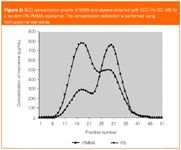
Figure 3
A comparison of the analysis of PMMA–PS copolymers with SEC– Py-GC–MS and SEC–dRI is shown in Figure 4. Roughly, the SEC-dRI signal reflects the sum of the concentration of styrene and MMA. No differentiation between the two monomers is possible. To assist the comparison, the SEC–Py-GC–MS results are also presented as the sum of the styrene and MMA levels. Clearly the dRI results and the Py-GC–MS data are in good agreement. The ratios between the two peaks in dRI and Py-GC–MS are different, because the dRI signal depends not only on the concentration, but also on the refractive index (RI) of the respective monomer. The RI of the polymer may not always be the weighted average of those of the constituting monomers, jeopardizing the use of dRI detection for rigorous quantitation. Obviously, such confounding effects are absent in the Py-GC–MS analysis, where the signals of the individual monomers only depend on the levels of the respective monomers in the SEC effluent.
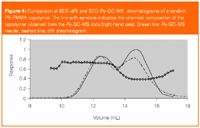
Figure 4
Even more challenging than the characterization of the random PMMA/PS dipolymer is the study of terpolymers. A polymer of interest in our studies was a tri-block copolymer of PMMA, polybutylacrylate (PBA) and polycaprolacton (PCL). The synthesis of this terpolymer was performed as follows. First a PCL polymer was activated by attaching a reactive end-group to the chain. Next an initiator was added, followed by addition of BA to form a PCL–PBA block copolymer. Finally, MMA was added to obtain the terpolymer. The first step in the characterization of the terpolymer was to determine the average composition of the material. To do so, for each of the three monomers Py-GC–MS calibration lines were constructed, relating fragment area to polymer concentration. Again, homopolymer standards were used for this purpose. Characteristic fragments for the respective monomers were chosen to construct the lines. For all homopolymers the most abundant peak in the GC chromatogram was the monomer itself. The mass/charge (m/z) values selected were 71, 84 and 100 for BA, CL and MMA, respectively.
The MS was operated in the selected ion monitoring (SIM) mode to improve the detection limits. For the individual homopolymers excellent calibration lines were obtained, all with correlation coefficients better than 0.997. The determination of the average chemical composition of the terpolymer was done by injection of a complete (not separated) solution directly into the Py-GC–MS system under the same conditions as applied for the construction of the calibration lines. As expected, the composition of the terpolymer was in a good agreement with the molar ratio of the monomers consumed during the polymerization reaction. To determine the chemical composition as a function of the molecular weight, the terpolymer was then analysed using the SEC–Py-GC–MS approach. Figure 5 shows the result of this analysis. The figure was constructed by plotting the concentration of the three different monomers versus the fraction number. Clearly, it can be seen that the distributions of PBA and PMMA follow a similar profile. Also PCL is present across the entire molecular-weight range. It is hence reasonable to assume that some terpolymer has indeed been formed. However, a substantial part of the PCL is clearly not incorporated in the terpolymer. Its molecular weight is still identical to that of the starting material. This result convincingly demonstrates the usefulness of the proposed SEC– Py-GC–MS method for the quantitative characterization of complex copolymer systems.
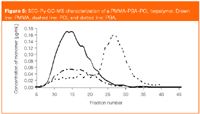
Figure 5
Conclusions
SEC–Py-GC–MS has great potential for the characterization of complex copolymer systems. For the polymers studied here Py-GC–MS was proven rigorously quantitative. Neither the composition of the polymer, nor its MW, nor the concentrations in the SEC effluent were found to affect the pyrolysis reaction. Therefore, homopolymers can be used as calibrants for quantitative compositional characterization of complex copolymer systems. The results obtained by automated on-line SEC–Py-GC–MS were compared with results from SEC with conventional UV and dRI detection. Py-GC–MS clearly provides information that cannot be obtained from the more conventional detection strategies. The new method showed excellent performance in terms of selectivity, repeatability, and reliability and allowed the complete characterization of composition as a function of molecular size for a variety of complex polymers.
References
1. H.J.A. Philipsen, J. Chromatogr. A, 1037, 329–350 (2004).
2. L. Coulier, E.R. Kaal and Th. Hankemeier, Pol. Deg. and Stab., 91, 271–279 (2006).
3. L. Verdurmen-Noël, L. Baldo and S. Bremmers, Polymer, 42, 5523–5529 (2001).
4. M.S. Montaudo, Polymer, 43, 1587–1597 (2002).
5. S.J. Kok et al., J. Chromatogr. A, 948, 257–265 (2002).
6. H.G.J. Mol et al., Trends in Anal. Chem., 15, 206–214 (1996).
7. M.H.P.M. van Lieshout, H.G. Janssen and C.A. Cramers, J. High Resol. Chromatogr., 19, 193–199 (1996).
8. S. de Koning et al., J. Sep. Sci., 27, 397–409 (2004).
9. E.R. Kaal et al., J. Chromatogr. A, 1143, 182–189 (2007).
10. M. van Hulst and E.R. Kaal, Manuscript in preparation.
Erwin Kaal is an application specialist at ATAS GL and a PhD student at the Van 't Hoff Institute for Molecular Sciences, University of Amsterdam, Amsterdam, The Netherlands. His PhD project focuses on extending the applicability of GC and GC–MS.
Mitsuhiro Kurano is an international sales manager at GL Sciences and director of the sister company ATAS GL in Veldhoven, The Netherlands.
Margit Geiβler is the international product specialist for GC and GC–MS at Shimadzu Europe, Duisburg, Germany.
Hans-Gerd Janssen is group leader chromatography and mass spectrometry at the Unilever Food and Health Research Institute in Vlaardingen, The Netherlands. He is also a part-time professor in biomacromolecular separations at the University of Amsterdam, Amsterdam, The Netherlands.
Peter Schoenmakers holds a chair in analytical chemistry and is head of the polymer analysis group of the Van 't Hoff Institute for Molecular Sciences, University of Amsterdam, Amsterdam, The Netherlands.
Column Editor, Robert Smits, is the president of the Koninklijke Vlaamse Chemische Vereniging (Royal Flemish Chemical Society). He is Chairman of the biennial "International Symposium on Hyphenated Techniques in Chromatography and Hyphenated Chromatographic Analysers" and a member of the Editorial Advisory Board of LC•GC Europe.

New Study Reviews Chromatography Methods for Flavonoid Analysis
April 21st 2025Flavonoids are widely used metabolites that carry out various functions in different industries, such as food and cosmetics. Detecting, separating, and quantifying them in fruit species can be a complicated process.
University of Rouen-Normandy Scientists Explore Eco-Friendly Sampling Approach for GC-HRMS
April 17th 2025Root exudates—substances secreted by living plant roots—are challenging to sample, as they are typically extracted using artificial devices and can vary widely in both quantity and composition across plant species.
Sorbonne Researchers Develop Miniaturized GC Detector for VOC Analysis
April 16th 2025A team of scientists from the Paris university developed and optimized MAVERIC, a miniaturized and autonomous gas chromatography (GC) system coupled to a nano-gravimetric detector (NGD) based on a NEMS (nano-electromechanical-system) resonator.

.png&w=3840&q=75)

.png&w=3840&q=75)



.png&w=3840&q=75)



.png&w=3840&q=75)



